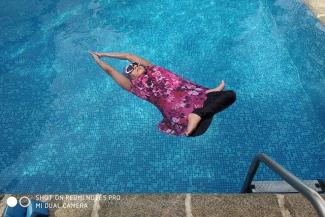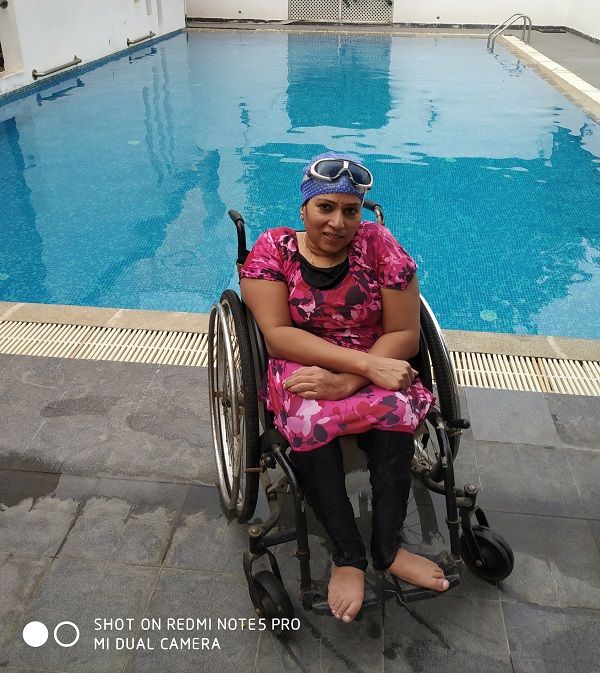
Madhavi Latha Prathigudupu, who has been using a wheelchair since childhood due to polio linked paralysis, found a world of freedom when she started physiotherapy and yoga in water. Now she is in the forefront advocating aquatherapy to others disabled in the community.
Could you tell us a little bit about yourself and your disability?
I was born in a remote village in South India. I have a very loving and caring family. Today, whatever I am able to achieve in my life is mainly because of the unstinted support of my parents. Currently, I am working with a multinational bank as associate vice-president.
I was affected by a massive polio attack when I was seven months old. It left me with scoliosis and paralysed legs. After undergoing surgery for correction of deformed legs, doctors advised me to wear calipers extending from below my shoulders to my toes. As the calipers were made of iron those days, they were extremely heavy and painful to move in, and hence I was reluctant to use them. Most of my childhood, I would prefer to sit in one place and concentrate on my studies. I totally restrained myself from using calipers and doing exercises. But because of which, my condition has worsened. I have developed severe scoliosis or abnormal curvature of the spine that completely compresses one lung and partially compresses the other lung. I also developed hiatus hernia.
Read more about Madhavi Latha, National Paralympics Swimming Champion and President of the Wheelchair Basketball Association of India. She founded the “Yes We Too Can” initiative – helping train and support paralympic sportspeople.
At what age were you first introduced to the water?
I was introduced to water therapy when I was 37 years.
You practiced hydrotherapy for a while. What were the key exercises in hydrotherapy?
I regularly practice all four types of swimming (freestyle, back stroke, butterfly, breast stroke). I also do stretching exercises and dumbbells in water.
How did you gain personally with exercises in water?
In 2007, after seeing my spine condition, I was told by a senior orthopedic surgeon that my life span would be only one year in the absence of spinal surgery. I was also told that in my condition chances of surgery being successful were minimal. After a lot of brainstorming, we finally decided not to opt for surgery and try homeopathy instead. Simultaneously, I started going for physiotherapy. It was Dr Ananda Jothi, my physiotherapist, who suggested I try hydrotherapy as a part of physiotherapy. Initially I was reluctant, but I soon realized that water is the best place for me to practice yoga and physio. Due to the property of buoyancy in water, I was lighter and able to perform movements more freely under water without any assistance of external devices. I also felt water gave me a world of freedom and enjoyment which helped me to lead an active life till date, despite the challenges I have.

Recently, you started aquatherapy, which includes dance, yoga and physiotherapy in water, for the disabled. Could you give us the details about this initiative?
Aquatherapy for disabled has existed in India for a long time. I am not the first person to start the initiative. However, I have been trying to create awareness since 2011, through my movement “Yes We Too Can" by giving talks in various forums. Through our paralympic swimming association of Tamil Nadu, we were able to introduce swimming to more than 300 disabled people in our state alone. I started practising Yoga after I met Dr N Chandrasekhar, a renowned yoga therapist. I found it difficult to practice some asanas on the ground. As per the suggestions of Dr Chandrasekhar (see box below), I started trying them under water by adopting some changes according to my physical condition. This made me realize that my body is more flexible under water.
Why not try aqua dance, I thought. I discussed the idea with my friend Gopal, who is a dancer and choreographer. So, along with some of my friends we started the aqua dance sessions. We are in the process of giving it more structure and proper shape.
How have you benefitted from dancing, doing yoga and physiotherapy?
Accomplishing things under water which I never even dreamt of doing outside has multiplied my confidence levels greatly. Most importantly, it is giving me immense happiness.
Have you experienced any medical benefits from aquatherapy?
Definitely. Due to aquatherapy, I am able to maintain my day-to-day activities in life despite severe spine compression. Also, as making movements under water is interesting, it has motivated me to continue with my swimming, yoga and other workouts under water. I would love to be under water always, if possible.
Has there been any reduction in your spine compression?
Probably, if I had started swimming as a child, the spinal compression would not have reached this stage or worsened. As I started at age 37, now I am able to maintain my health without further deterioration. Hence, it is important to create awareness among children/parents and youngsters about the benefits of aquatherapy. We can help them lead a near normal life.
Aquatherapy or being active in water is a relatively new field for people who have been wheelchair users all their life. How does it feel to be swimming or performing other activities as skilfully as an able bodied person?
The confidence level and happiness that I gain in the pool doing aquatherapy have been influencing my activities in the outside world. I feel aquatherapy is a wonderful process to empower persons with disability in a friendly, joyful and comfortable manner.
What are the challenges of getting into the pool from the wheelchair and exercising in water?
Entering into the pool is relatively easy compared to coming out of the pool. Someone has to help us to come out of the pool, mishandling of which may cause injuries too. Shifting from ground to the wheelchair is another challenging task. Having swimming pool lifts / ramps with fiber wheelchairs, will make our life comfortable.
Would you recommend Aquatherapy to other centres across India?
Absolutely
Yoga Therapist Dr. N. Chandrasekaran says:
The focus for yoga for disabled persons should be:
1) To maintain the available mobility of the joints
Mobility of the joint is made easier under water. It is because, as we all know that the body weight is reduced under water. Standing postures may be very difficult or impossible for many people with disability, but in water it is possible.
2) To maintain the available strength of the muscles/ To improve the functionality of back muscles
Lying prone or face down postures are important for improving the vertebral mobility and to strengthen back muscles. In water, these movements are a possible, but on land it is not feasible for many.
3) To facilitate pelvic opening
Pelvic opening in both directions are very important for all disabled people. These movements are also made easier when practiced in water.
4) To encourage mobility of all joints in all possible directions
An important feature of practice in water is that ‘the individual has to move the entire musculature to maintain floating’. This will activate all the muscles in the body. Another special feature about water is its effect on the mind. The mind develops a playful, childlike attitude. Water also provides relief from the routine.






